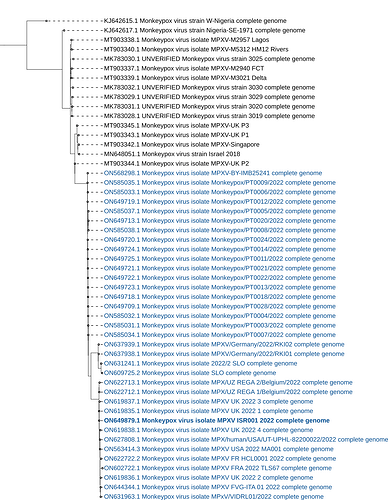Ofir Israeli1, Yehoudit Guedj-Dana1, Shirley Lazar1, Ohad Shifman1, Noam Erez2, Shay Weiss2, Nir Paran2, Tomer Israely2, Ofir Schuster2, Anat Zvi1, Adi Beth-Din1 and Inbar Cohen Gihon1
1Department of Biochemistry and Molecular Genetics, Israel Institute for Biological Research, Ness Ziona, Israel
2Department of Infectious Diseases, Israel Institute for Biological Research, Ness Ziona, Israel.
Here we report the whole-genome sequence of a monkeypox virus strain isolated from a male patient on May 20, 2022. After traveling back from Belgium and Germany to Israel, he was hospitalized with pox-like lesions. Pustule swab samples were analyzed by PCR, according to the method described by Shchelkunov et al. [1] and were positive for MPXV (West African clade).
A whole genome sequencing was performed using the Illumina platform. A Nextera XT paired-end library (Illumina) was prepared using 1 ng of DNA extracted from the patient’s pustule swab, using a QIAamp DNA mini kit (Qiagen). The library was sequenced on the MiSeq platform using paired-end sequencing, with a read length of 150 nt and a mean insert size of 215 nt. Quality control and trimming of the raw reads were performed using TrimGalore [2] with default parameters. Human reads were filtered out using bowtie2 [3] and samtools [4]. This produced 1,071,598 clean monkeypox paired-end reads out of 16,262,769 total reads (6.5%), with 1300x coverage in mapping to MPXV genomes. The paired-end reads were de-novo assembled using SPAdes assembler v3.13.0 [5] with the --careful parameter. For manual curation and validation, the paired-end reads were mapped to the genome MPXV_USA_2022_MA001 (accession no ON563414). The complete sequence, MPXV_ISR001_2022, consists of 196,753 bp (G+C content, 33.1%), was submitted to NCBI GenBank and is available under accession no ON649879.
In a phylogenetic analysis, the genomic sequence of MPXV_ISR001_2022 was compared to all publicly available complete MPXV genome sequences in the NCBI database as of June 2, 2022. Multiple sequence alignments were carried out using MAFFT v7.490 [6] and a maximum likelihood phylogenetic tree inference was applied using RAxML v8.2.11 [7] with default parameters. Phylogenetic tree display was implemented using Interactive Tree of Life (iTOL) v6 [8]. The MPXV_ISR001_2022 sequence is clustered with the current 2022 published MPXV sequences and harbors the pattern of dinucleotide changes described by O’Toole & Rambaut [9]. The sequence revealed 47 substitutions in comparison to a 2018 representative genome (Israel_2018).
Figure1. Phylogenetic tree of representative genomes not associated (black) and all available genomes associated (blue) with the 2022 multi-country MPXV outbreak, including MPXV_ISR001_2022 (in bold).
References
- Shchelkunov SN, Gavrilova EV, Babkin IV. Multiplex PCR detection and species differentiation of orthopoxviruses pathogenic to humans. 2005, Mol Cell Probes 19:1–8.
- Babraham Bioinformatics - Trim Galore!
- Langmead B, Salzberg S. Fast gapped-read alignment with Bowtie 2. Nature Methods. 2012, 9:357-359.
- Li H, Handsaker B, et al. The Sequence Alignment/Map format and SAMtools. Bioinformatics. 2009 Aug 15;25(16):2078-9.
- Bankevich A., Nurk S., et al. SPAdes: A New Genome Assembly Algorithm and Its Applications to Single-Cell Sequencing. 2012, Journal of Computational Biology
- K. Katoh, K. Misawa, K. Kuma, and T. Miyata. MAFFT: a novel method for rapid multiple sequence alignment based on fast Fourier transform.2002, Nucleic Acids Res, vol. 30, no. 14, pp. 3059–3066, Jul.
- Stamatakis, A. RAxML Version 8: A tool for Phylogenetic Analysis and Post-Analysis of Large Phylogenies. 2014, In Bioinformatics.
- Letunic and Bork. Interactive Tree Of Life (iTOL) v5: an online tool for phylogenetic tree display and annotation. 2021, Nucleic Acids Volume 49
- Áine O’Toole & Andrew Rambaut. Initial observations about putative APOBEC3 deaminase editing driving short-term evolution of MPXV since 2017. Virological. May 30, 2022. https://pando.tools/t/830
